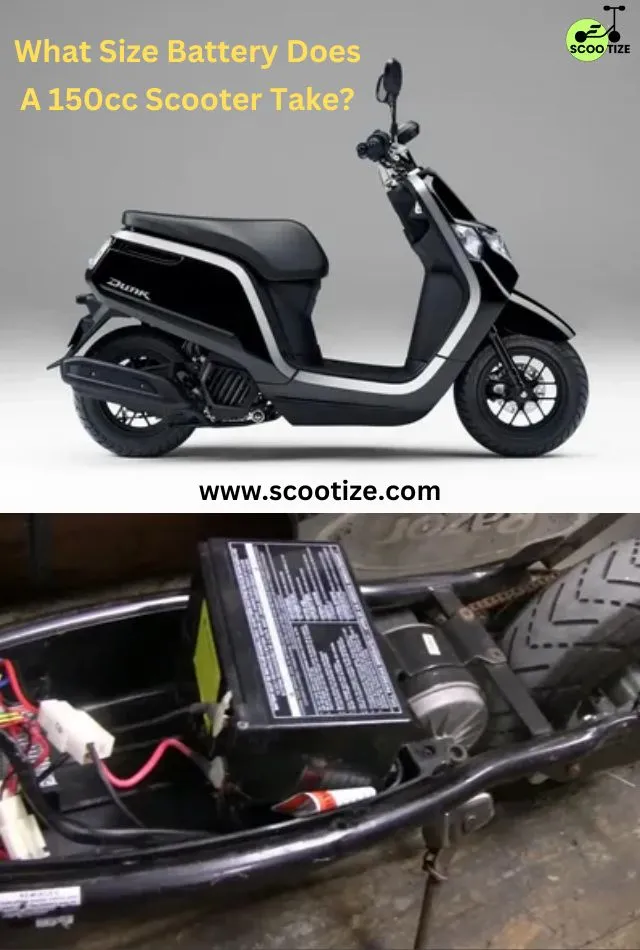One critical component is the battery when maintaining and smoothly operating your 150cc scooter. The correct battery ensures that your scooter starts reliably, powers all the electrical systems effectively, and performs at its best. What Size Battery Does A 150cc Scooter Take?
This blog post will delve into the essential factors determining the appropriate battery size for a 150cc scooter. We’ll explore the various types of batteries available, their specifications, and how to choose the right one for your specific model.
By the end of this read, you’ll be equipped with the knowledge to make informed decisions, ensuring your scooter remains in top-notch condition and ready for the road ahead.
So, let’s embark on this journey to demystify the world of scooter batteries and find out what size battery your 150cc scooter truly needs.
What Is Normal Battery Voltage for Scooter?
Electric scooters are becoming increasingly popular as a mode of transportation. A common question among scooter owners is: What is the standard battery voltage for a scooter? Knowing this can help you maintain your scooter and prolong its life.
Typically, the battery voltage for most scooters ranges between 12 and 14 volts. This range ensures optimal performance and reliability. It’s important to check the battery voltage regularly to avoid unexpected breakdowns.
A 12-volt battery is usually standard for a 150cc scooter. This battery provides sufficient power to start the scooter and run its electrical components. Always use the recommended battery size for your scooter model to ensure proper functionality.
A multimeter is used to measure the battery voltage. Set it to the DC voltage setting and connect the probes to the battery terminals. If the reading is below 12 volts, recharging or replacing the battery might be time.
Regular maintenance of your scooter’s battery is crucial. Keep the terminals clean and free from corrosion. Store your scooter in a cool, dry place to extend the battery life.
In summary, the normal battery voltage for most scooters is between 12 and 14 volts. A 12-volt battery is standard for a 150cc scooter. Regular checks and proper maintenance can help you avoid problems and enjoy a smooth ride.
What Size Battery Is In A Scooter?
Choosing the correct battery for your 150cc scooter is crucial. Most 150cc scooters use a 12-volt battery, which typically ranges between 5Ah and 9Ah. This ensures your scooter starts reliably and powers essential systems.
When selecting a battery, consider your scooter’s brand and model. Check your scooter’s manual for specific recommendations. Many popular scooter brands, like Honda, Yamaha, and Vespa, use 12-volt batteries. However, the exact size can vary slightly.
Maintenance-free batteries are a great option. They require less upkeep and provide consistent power. Lithium-ion batteries are another modern choice. They are lighter and last longer than traditional lead-acid batteries.
Remember to check the battery’s dimensions and ensure it fits snugly in the scooter’s battery compartment. Proper installation is key to optimal performance.
In summary, a 150cc scooter typically takes a 12-volt battery with a capacity of 5Ah to 9Ah. Always follow manufacturer guidelines for the best results.
What Size Battery Does A 150cc Scooter Take?
A 150cc scooter typically requires a specific type of battery. The size and type of battery are crucial for the scooter’s performance and longevity.
This guide will explain the standard battery specifications for a 150cc scooter and provide tips for maintaining and replacing it.
Battery Size and Type
Most 150cc scooters use a 12-volt battery. The amp-hour (Ah) rating usually ranges between 6Ah and 9Ah. This rating indicates how much power the battery can store and supply.
Standard dimensions for these batteries are approximately 150mm long, 87mm in width, and 105mm in height. However, these dimensions can vary slightly depending on the manufacturer and model.
Types of Batteries
Lead-Acid Batteries:
- Most common and affordable.
- Require regular maintenance.
- Electrolyte levels must be checked, and terminals must be kept clean.
AGM (Absorbed Glass Mat) Batteries:
- It’s more expensive than lead acid.
- Maintenance-free.
- Offer better performance and longer life.
Lithium-Ion Batteries:
- Lightest and most efficient.
- More expensive.
- Require a compatible charger.
Choosing the Right Battery
Check the scooter’s manual for the recommended battery type and size. Ensure the battery fits snugly in the battery compartment. Avoid using a battery with a higher or lower voltage than recommended.
Capacity and Cold Cranking Amps (CCA)
- Capacity (Ah): Choose a battery within the recommended range (usually 6Ah to 9Ah).
- Cold Cranking Amps (CCA): Higher CCA is better for cold weather starts. Ensure the battery meets or exceeds the scooter’s CCA requirements.
Brand and Quality
Opt for reputable brands to ensure reliability and longevity. Avoid cheap, generic batteries that may not perform well or last long.
Installation and Maintenance
- Safety First: Wear gloves and eye protection.
- Remove Old Battery: Disconnect the negative (-) terminal first, then the positive (+). Remove the old battery.
- Install New Battery: Place the new battery in the compartment. Connect the positive (+) terminal first, then the negative (-).
- Secure the Battery: Ensure the battery is fastened to prevent movement during rides.
Maintenance Tips
- Regular Checks: Inspect the battery terminals and clean any corrosion.
- Charge Regularly: Use a compatible charger to maintain the battery’s charge, especially during long periods of inactivity.
- Storage: Store the battery in a cool, dry place if not used for an extended period.
Signs of a Failing Battery
- Slow Engine Crank: The engine takes longer to start.
- Dim Lights: Headlights and other electrical components appear dim.
- Low Voltage: A multimeter shows a voltage below 12V.
- Corrosion: Visible corrosion on the battery terminals.
Choosing the correct battery for a 150cc scooter is essential for optimal performance. For specific recommendations, always refer to the scooter’s manual.
Opt for high-quality, compatible batteries and follow proper installation and maintenance practices. Regular checks and timely replacements will ensure your scooter runs smoothly and reliably.
How Do I Choose A Battery For My Scooter?
Choosing the correct battery for your scooter is crucial. It ensures smooth rides and long-lasting performance. Here’s a simple guide to help you make the best choice.
First, determine the battery size. If you’re asking, “What size battery does a 150cc scooter take?” you’ll need a 12V battery. This is the standard size for many scooters. Check your scooter’s manual to confirm.
Next, consider the battery type. There are mainly two types: lead-acid and lithium-ion. Lead-acid batteries are cheaper but heavier. Lithium-ion batteries are lighter and last longer, though they cost more.
Check the battery’s capacity. This is measured in ampere-hours (Ah). A higher Ah means longer battery life. For a 150cc scooter, a battery with a capacity between 6Ah and 9Ah is ideal.
Look at the brand reputation. Choose a reliable brand known for quality. Brands like Yuasa, Exide, and Bosch are popular choices.
Lastly, ensure proper maintenance. Regularly check your battery’s charge and clean the terminals. This will extend its life and maintain performance.
In summary, find your scooter’s size, type, and capacity. Opt for a reputable brand and maintain it well. This will keep your scooter running smoothly.
I want to let you know more, Are Vitacci Scooters Good?
Can I Put A Bigger Battery In My Scooter?
Scooter enthusiasts often ask, “Can I put a bigger battery in my scooter?” The answer is yes but with some considerations. Upgrading your scooter’s battery can improve performance and extend range. However, it is essential to understand the implications.
First, check the scooter’s battery compartment size. Ensure the new battery fits without modifications. Next, consider the voltage and capacity. A higher voltage battery can damage the scooter’s electronics. Stick to the same voltage, but you can opt for a higher capacity for longer rides.
Additionally, consider the type of battery. Lithium-ion batteries are famous for their efficiency and longevity. They are lighter and charge faster than lead-acid batteries.
Before upgrading, consult your scooter’s manual or a professional. Ensuring compatibility will prevent potential issues. Can you put a bigger battery in your scooter? Yes, but do it wisely for the best results.
Are All Scooter Batteries The Same?
Not all scooter batteries are the same. They come in various types, sizes, and capacities. Common types include lead-acid, AGM (Absorbed Glass Mat), and lithium-ion batteries.
Lead-acid batteries are the most common and affordable but need regular maintenance. AGM batteries cost more but are maintenance-free and offer better performance. Lithium-ion batteries are the lightest and most efficient but most expensive and require a compatible charger.
Batteries also differ in voltage and amp-hour (Ah) ratings. Most scooters use 12-volt batteries, but the capacity can vary. Check your scooter’s manual for the recommended battery type and specifications.
Choosing the correct battery ensures your scooter performs optimally and has a longer lifespan. Always select a high-quality, compatible battery for the best results.
Final Words About What Size Battery Does A 150cc Scooter Take?
Generally, Selecting the correct battery for a 150cc scooter ensures optimal performance and longevity. Typically, these scooters require a 12-volt battery, which can vary in amp-hour (Ah) ratings depending on the specific model and manufacturer’s recommendations.
Moreover, it’s essential to consult your scooter’s manual or a trusted dealer to determine the exact specifications needed. When proper maintenance and timely battery replacement will keep your scooter running smoothly and reliably.
By understanding the importance of the battery’s size and specifications, you can make an informed decision that best suits your scooter’s needs.

